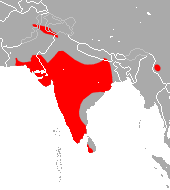Fulvus roundleaf bat
The fulvus roundleaf bat or fulvus leaf-nosed bat (Hipposideros fulvus) is a species of bat in the family Hipposideridae. It is found in Afghanistan, Bangladesh, Cambodia, China, India, Laos, Myanmar, Pakistan, Sri Lanka and Thailand and possibly in Vietnam.[1]
| Fulvus roundleaf bat | |
|---|---|
.jpg) | |
| Location: Manpeshwar CaveDahisar, Mumbai | |
| Scientific classification | |
| Kingdom: | Animalia |
| Phylum: | Chordata |
| Class: | Mammalia |
| Order: | Chiroptera |
| Family: | Hipposideridae |
| Genus: | Hipposideros |
| Species: | H. fulvus |
| Binomial name | |
| Hipposideros fulvus Gray, 1838 | |
 | |
| Fulvus roundleaf bat range | |
Taxonomy
The fulvus roundleaf bat was described as a new species in 1838 by British zoologist John Edward Gray. The holotype had been collected by Walter Elliot in the Madras, India (now Chennai). Gray stated that its fur was "reddish fulvous", giving it the species name "fulvus".[2]
Description
Individuals have a forearm length of 38–44 mm (1.5–1.7 in) and weigh 8–9 g (0.28–0.32 oz). It has large ears that are rounded at the tips. Its fur color is variable; individuals have been documented with pale yellow, golden orange, and pale gray fur.[3]
Range and habitat
It is native to Central and South Asia, and has been documented in the following countries: Afghanistan, Bangladesh, China, India, Pakistan, and Sri Lanka. It is found at a range of elevations from 0–2,600 m (0–8,530 ft) above sea level.[1]
Conservation
As of 2019, it is evaluated as a least-concern species by the IUCN. It meets the criteria for this classification because it has a wide—if patchy—geographic range, and it is not likely to be experiencing rapid population decline. It has a low population density, however, and is threatened by disturbance of its roosts.[1]
References
- Srinivasulu, B.; Srinivasulu, C. (2019). "Hipposideros fulvus". IUCN Red List of Threatened Species. 2019: e.T10135A22089934. doi:10.2305/IUCN.UK.2019-2.RLTS.T10135A22089934.en.
- Gray, J. E. (1838). "A revision of the genera of bats (Vespertilionidae), and the description of some new genera and species". Magazine of Zoology and Botany. 2 (12): 483–505.
- Smith, Andrew T. (2010). A Guide to the Mammals of China. Princeton University Press. p. 347. ISBN 9781400834112.
